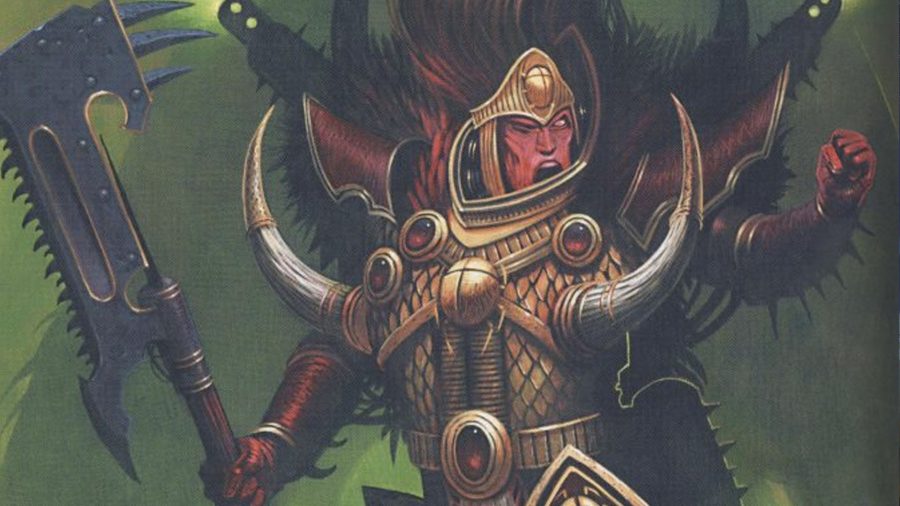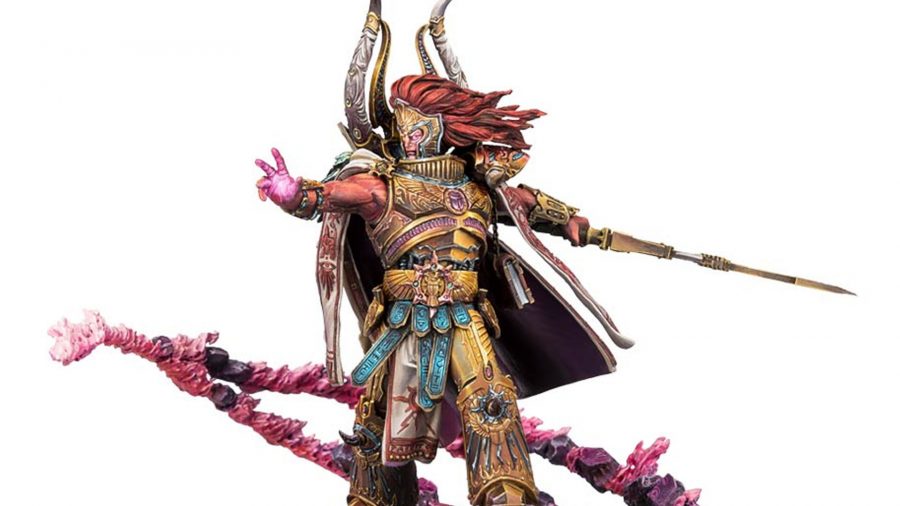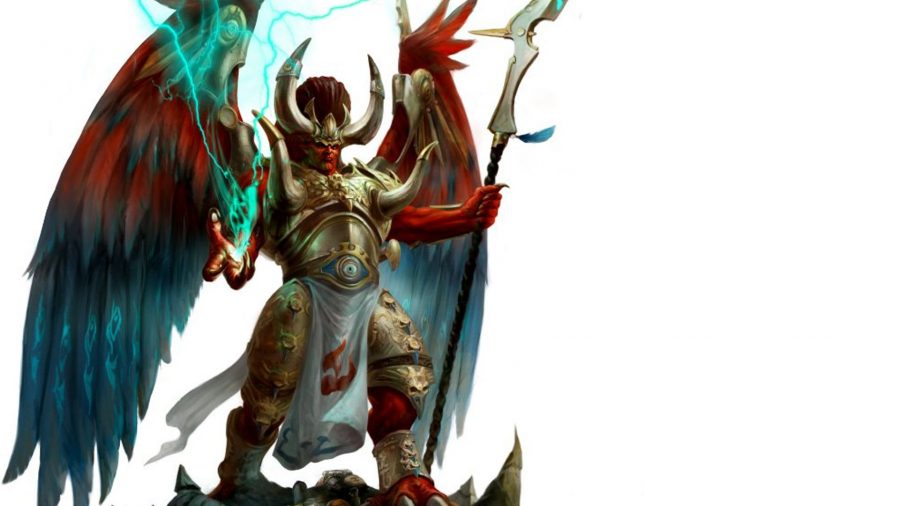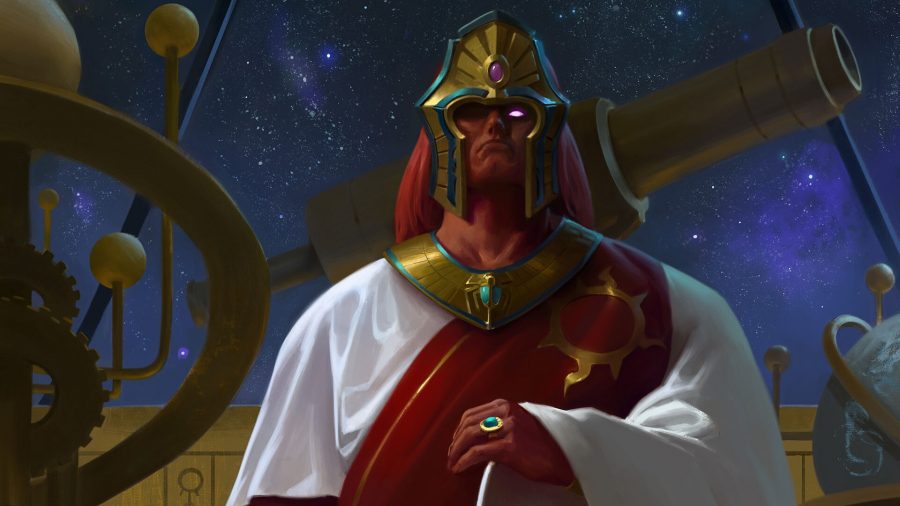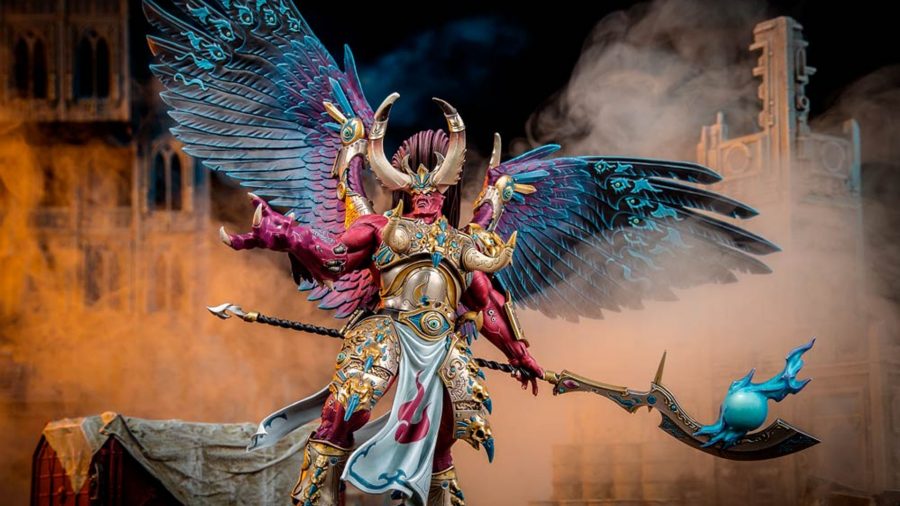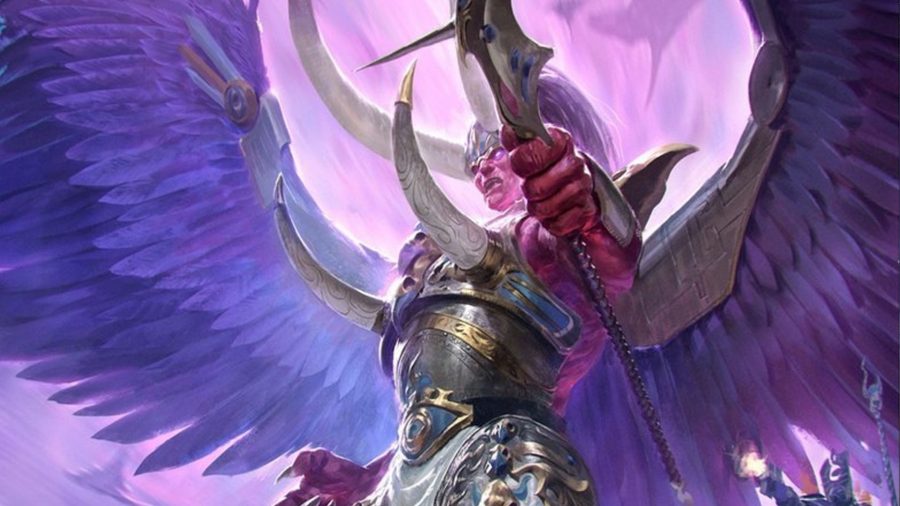Warhammer 40k‘s Magnus the Red, Primarch of the Thousand Sons Space Marine Legion, is one of the most divisive figures in the entire Games Workshop 40k universe. Some view him as a well intentioned Primarch who could’ve stayed loyal to the Imperium had things just been a little bit different. Others view him as a dangerous idiot, tearing apart the universe with colossal hubris. Either way, discussions on the Thousand Sons Primarch always run hot in fandom spaces.
Depending on how you view the character of Magnus the Red, he could seem one of the great tragic figures of Warhammer 40k, inexorably falling to Chaos like water circling a drain. Or you may see him as one who didn’t heed the warnings from those wiser and better informed than he was, toying with forces he was ill-equipped to handle.
“Magnus did nothing wrong” is the eternal refrain in such debates – always met with equal and opposite assertions that, actually, he did rather a lot wrong. We don’t profess to know the definitive truth behind Warhammer 40k’s Magnus the Red and his fall to Chaos – but we can give you all the information you need to make up your own mind.
Let’s take a look at the background of this most vermillion of Primarchs – then you, too, can have an opinion on whether or not he did something, or nothing, wrong.
Magnus the Red – a wizard falls
Magnus the Red – so known because of his unusual, copper-coloured skin – was always special, even amongst his Primarch peers being stolen and dispersed throughout the galaxy in their technological creches. He was aware, awake, and remembers everything of his journey. Landing on the planet Prospero, he was raised amongst psykers – the only place in the universe where that may have been possible.
His psychic powers quickly became apparent, as Magnus became the pre-eminent psyker on the planet, swiftly outclassing his teachers. Instead of simply drawing power from the Warp, Magnus looked into it, learning from its swirling depths in a way that no-one else ever could. It was during this time that he led his planet into glory, rebuilding cities, purging their enemies, and forming the core of what would become the Thousand Sons legion.
The true path: This is our ideal Horus Heresy book order
It didn’t take long for the Emperor to find his psychic son – and Magnus was quickly given command of his very own legion, now named the Thousand Sons after integrating Magnus’ own cabal of Prosperan sorcerers. Soon enough, Magnus discovered his legion, derived from his own gene-seed, was beset by horrific mutations.
In desperation, and seeing no other way to save them, Magnus made a terrible bargain trading an eye for a cure from a being he thought was merely a run-of-the-mill Warp entity. This entity was in fact the chaos god Tzeentch, sealing a mistake that would haunt Magnus for the rest of his years.
As the Great Crusade progressed, Magnus and his Thousand Sons proved themselves to be masters of the Warp; at least, they thought so. As his Primarch brothers began to encounter more creatures born of the Empyrean they learned to distrust Magnus, as his powers and summonings shared many similarities with daemon-kind. This resulted in the Council of Nikaea, a debate to decide once and for all if psychic powers should be banned in the Imperium. To Magnus’ great displeasure, they were, with all legions ordered to immediately cease any use of psykers.
Praetorian of Terra: Read our full guide to 40k’s Rogal Dorn
Magnus paid no heed to this edict, instead choosing to continue his investigations into the Warp in secret. It was on Prospero where he learned of the threat to the Imperium threatened by Horus and the impending civil war. Attempting to warn his father, the Emperor, he resorted to using mysterious powers born of the Warp to reach him in his throne room. Magnus did indeed succeed in reaching his father – but the cost was immeasurable.
Inside the throne room on Terra, a giant flaming figure walked out of the Webway, the secret project the Emperor was cultivating to free humanity from dependence on the Warp. Magnus tore a hole in the Webway as he attempted to reach the Emperor, causing daemons to flood it, and making it impossible for the Emperor’s work to continue. Millions on Terra died that day, and the Emperor himself viewed this act as the moment the future of humanity was sealed: we would never be free of the Warp, and would one day fall to Chaos.
The Emperor’s justice was brutal. Leman Russ and his Space Wolves were sent to Prospero to end the Thousand Sons and Magnus once and for all. There, in sorrow, Magnus refused to fight until the very last moment, teleporting his legion away to the Planet of the Sorcerers deep wihin the Eye of Terror.
Fear incarnate: Our guide to Warhammer 40k’s Konrad Curze
From here, Magnus’ power was magnified beyond measure. Despite feeling considerable remorse for his actions against the Emperor, he sided with traitors during the Horus Heresy, eventually joining them on their assault on Terra itself. Though he was stronger, he still refused to give himself entirely to Chaos – until a battle against Vulkan, Primarch of the loyalist Salamanders legion, almost cost him his life.
There he relented, giving himself wholly to the Ruinous Powers and to Tzeentch in particular, ascending to a new and more powerful form. Finally, as a mighty Daemon Prince, Magnus the Red had become the Crimson King in form as well as name.
Where is Magnus now?
After the failure of the Horus Heresy, Magnus fled to his tower on the Planet of the Sorcerers. There he plotted and schemed to bring down the Imperium – though, with time, he became subsumed by the Great Game (the endless warring between Chaos powers) becoming more and more Tzeentch’s tool. After all, as a Daemon Prince, his will may not entirely be his own any more.
Though he has become aloof from the affairs of mortals, he has descended a few times to wreak havoc upon real space. His vendetta against the Space Wolves continues to this day; a Thousand Sons attack on Fenris and its sister planet caused deep wounds for the sons of Leman Russ.
Red Angel: Read our guide to Warhammer 40k’s Sanguinius
In addition, as is often the case with the disciples of Tzeentch, it hid a plot to draw the Thousand Sons’ planet back into the real universe, and out of the Warp. A plot which, fuelled by the destruction on Fenris’ sister planet, was ultimately successful.
Since then, the Daemon Primarch Magnus the Red has been seen leading his legion during the Terran Crusade, and attempting to summon a horde of daemons during the days of the Dark Imperium. It is not known what his ultimate goal is – but chaos, devastation, and deep mysteries always walk alongside him.
Magnus the Red in Warhammer 40k
Like his brother in Chaos, Mortarion of the Death Guard, Magnus the Red has his own Warhammer 40k model that makes him a great inclusion for any Thousand Sons army. You may be utterly shocked to read it – after reading the above information about our rogue enchanter – but Magnus makes quite the powerful psychic spell-slinger on the tabletop battlefield.
As a supreme psyker, Magnus is capable of tossing out three psychic powers a round and can attempt to deny three enemy psychic powers. In addition, when at full health, he also gains a bonus to rolls when manifesting or denying physic powers – and you can re-roll Psychic tests. This definitely puts him in the top-tier of psykers – even before you get onto his special rules.
The first rule that’ll see your opponent gnash their teeth is Gaze of Magnus, a colossal buff to Smite that doubles the damage it deals. On top of having an aura that grants re-rolls of ones to hit, Magnus can also nominate one nearby Thousand Sons unit a re-roll for all failed hits. This makes him a solid force multiplier to keep near a high power unit you definitely want to see get some heavy hits in.
Outside of tossing spells, Magnus is no slouch in melee either. His Blade of Magnus does heavy damage by itself but also deals D3 additional wounds if the target model or unit is still alive. Now that’s tricksy.
Whilst he is psyker without peer, Magnus the Red isn’t the toughest of the Daemon Primarchs, and, if you’re used to fielding Mortarion and seeing him shrug off wounds left and right, you may be surprised at his squishiness.
Heretic brothers: Our Warhammer 40k Chaos Space Marines guide
Magnus is definitely a character to take for specific purposes, not as an all-round buff for your army. That said, what true Thousand Sons player could resist being accompanied by the Crimson Cyclops himself?
Still hungry for the heretical arts? Get the lowdown on Magnus’ psychic Space Marines with our guide to everything Thousand Sons. Expand your Chaos army with our in-depth look at every Chaos faction in Warhammer 40k. Or if it’s lore you’re after, our Horus Heresy reading order will be sure to fill in any blank spots.
Source: Wargamer




